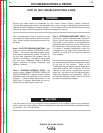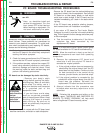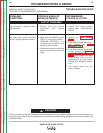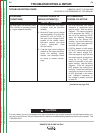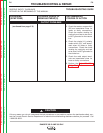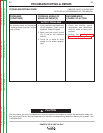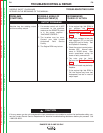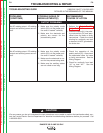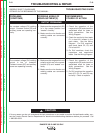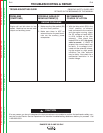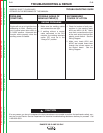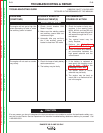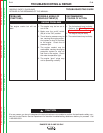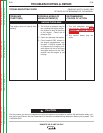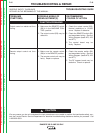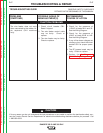
Return to Section TOC Return to Section TOC Return to Section TOC Return to Section TOC
Return to Master TOC Return to Master TOC Return to Master TOC Return to Master TOC
TROUBLESHOOTING & REPAIR
F-10 F-10
RANGER 300 D AND 300 DLX
OBSERVE SAFETY GUIDELINES
TROUBLESHOOTING GUIDE
DETAILED IN THE BEGINNING OF THIS MANUAL.
CAUTION
If for any reason you do not understand the test procedures or are unable to perform the test/repairs safely, con-
tact the Lincoln Electric Service Department for electrical troubleshooting assistance before you proceed. Call
1-800-833-9353.
PROBLEMS
(SYMPTOMS)
POSSIBLE AREAS OF
MISADJUSTMENT(S)
RECOMMENDED
COURSE OF ACTION
OUTPUT PROBLEMS
No constant voltage (CV) welding
output. Constant current (CC) and
auxiliary power are operating nor-
mally.
1. Make sure the range switch (S2)
is in the proper position and
“seated” correctly.
2. Make sure the wire feeder and
welding cables are connected
correctly.
1. Check the operation of the
range switch (S2) and check the
associated wires for loose or
faulty connections. See the
Wiring Diagram.
2. Check the continuity from leads
C1 to lead W1 located in the
main stator. See the Wiring
Diagram. On DLX machines,
also check leads C2, C3, and
C4 to lead W1.
3. On DLX machines, check the
capacitors and associated
leads. See the Wiring Diagram.
The constant voltage (CV) welding
output is low or unstable.
Constant current (CC) and auxiliary
power are operating normally.
1. Make sure the range switch and
polarity switch are in the correct
position (CV) and “seated” cor-
rectly.
2. Make sure the wire feeder and
welding cables are connected
correctly.
1. Check the operation of the
range switch (S2) and check the
associated wires for loose or
faulty connections. See the
Wiring Diagram.
2. On DLX machines the capacitor
bank (C2, C3, C4, and C5) may
be faulty. Check or replace.



